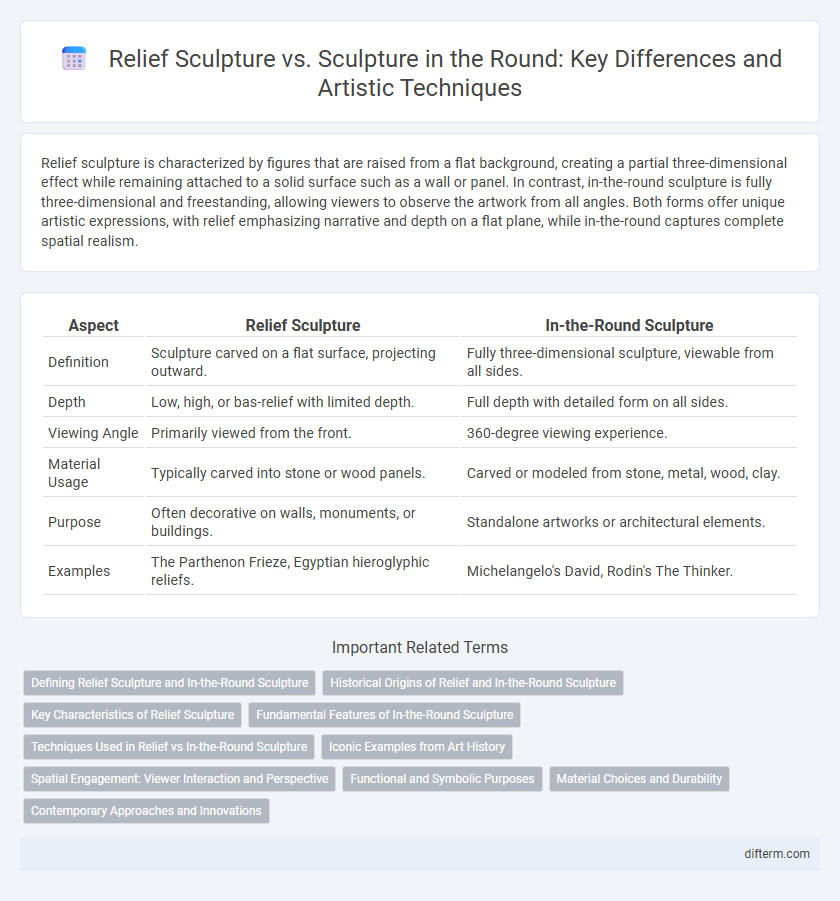Relief sculpture is characterized by figures that are raised from a flat background, creating a partial three-dimensional effect while remaining attached to a solid surface such as a wall or panel. In contrast, in-the-round sculpture is fully three-dimensional and freestanding, allowing viewers to observe the artwork from all angles. Both forms offer unique artistic expressions, with relief emphasizing narrative and depth on a flat plane, while in-the-round captures complete spatial realism.
Table of Comparison
| Aspect | Relief Sculpture | In-the-Round Sculpture |
|---|---|---|
| Definition | Sculpture carved on a flat surface, projecting outward. | Fully three-dimensional sculpture, viewable from all sides. |
| Depth | Low, high, or bas-relief with limited depth. | Full depth with detailed form on all sides. |
| Viewing Angle | Primarily viewed from the front. | 360-degree viewing experience. |
| Material Usage | Typically carved into stone or wood panels. | Carved or modeled from stone, metal, wood, clay. |
| Purpose | Often decorative on walls, monuments, or buildings. | Standalone artworks or architectural elements. |
| Examples | The Parthenon Frieze, Egyptian hieroglyphic reliefs. | Michelangelo's David, Rodin's The Thinker. |
Defining Relief Sculpture and In-the-Round Sculpture
Relief sculpture is a form of art where figures are carved or molded to project from a flat background, creating a sense of depth while remaining attached to a solid surface. In-the-round sculpture, also known as free-standing sculpture, is fully three-dimensional and can be viewed from all angles, as it is detached from any background. Relief sculpture is commonly found in architectural contexts like friezes and plaques, whereas in-the-round sculpture includes statues and figurines designed for immersive visual engagement.
Historical Origins of Relief and In-the-Round Sculpture
Relief sculpture originated in ancient Mesopotamia and Egypt, where artists carved images into flat surfaces to narrate religious and historical events, merging two-dimensional and three-dimensional art forms. In contrast, in-the-round sculpture dates back to prehistoric times, exemplified by Venus figurines, emphasizing fully three-dimensional, freestanding figures meant to be viewed from all angles. Both forms evolved with cultural practices, influencing architectural decoration and ceremonial artifacts throughout history.
Key Characteristics of Relief Sculpture
Relief sculpture is characterized by its raised elements that project from a flat background, creating a visual depth without being fully three-dimensional. It exists primarily on a two-dimensional plane, with varying degrees of projection such as bas-relief (low relief) and alto-relief (high relief). This technique is often used in architectural contexts and historical monuments to convey narratives within confined spatial boundaries.
Fundamental Features of In-the-Round Sculpture
In-the-round sculpture is characterized by its full three-dimensional form, allowing it to be viewed from all angles without a background or support surface, unlike relief sculpture which is attached to a flat plane. This type of sculpture emphasizes depth, volume, and spatial presence through detailed manipulation of the entire figure, creating a lifelike representation that occupies physical space. Materials commonly used include marble, bronze, and wood, chosen for their durability and ability to capture intricate details in a free-standing composition.
Techniques Used in Relief vs In-the-Round Sculpture
Relief sculpture involves carving or molding figures that project from a flat background, utilizing techniques such as bas-relief or high relief to create varying depths and shadows. In-the-round sculpture requires shaping a fully three-dimensional form that can be viewed from all angles, often using modeling, carving, or casting methods with materials like marble, bronze, or clay. Both techniques demand mastery of depth perception and texture to achieve realism and emotional impact.
Iconic Examples from Art History
Relief sculpture, exemplified by the intricate panels of the Parthenon Frieze, integrates figures into a flat background, creating depth through varying levels of projection. In-the-round sculpture, such as Michelangelo's David, is fully three-dimensional and meant to be viewed from all angles, emphasizing lifelike presence and detailed anatomy. These iconic examples highlight distinct approaches to form and space, shaping the evolution of sculptural art.
Spatial Engagement: Viewer Interaction and Perspective
Relief sculpture creates a dynamic spatial engagement by integrating the artwork with a flat background, encouraging viewers to experience depth through varied perspectives and shadow play. In-the-round sculpture invites viewers to move around the piece, offering a fully immersive, 360-degree interaction that reveals intricate details from multiple angles. The distinct spatial interaction in relief versus in-the-round sculpture fundamentally shapes how audiences perceive and emotionally connect with the artwork.
Functional and Symbolic Purposes
Relief sculptures are designed primarily for architectural integration, enhancing surfaces while conveying symbolic narratives through layered depth, often representing historical or religious themes on walls and monuments. In-the-round sculptures serve a functional role as freestanding art pieces, allowing viewers to engage with the work from multiple angles and providing a dynamic spatial experience. Both forms fulfill symbolic purposes, with reliefs emphasizing storytelling in confined spaces and in-the-round sculptures embodying presence and physicality in public or private settings.
Material Choices and Durability
Relief sculptures, often crafted from materials like stone, plaster, or metal, benefit from their partial attachment to a background, enhancing structural stability and resistance to environmental wear. In-the-round sculptures, typically made from marble, bronze, or wood, require materials with inherent strength and durability to withstand full exposure and handling from all angles. The choice of material directly impacts the longevity and maintenance needs, with bronze offering superior weather resistance for in-the-round works compared to more fragile and erosion-prone materials used in reliefs.
Contemporary Approaches and Innovations
Contemporary relief sculpture integrates mixed media and digital technology, enhancing depth perception and narrative complexity on flat surfaces. In-the-round sculpture embraces interactive and immersive elements, often employing augmented reality and 3D printing to challenge traditional spatial boundaries. Innovations in both forms push artistic expression beyond physical constraints, engaging viewers through multisensory experiences and conceptual layering.
Relief sculpture vs in-the-round sculpture Infographic

 difterm.com
difterm.com